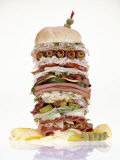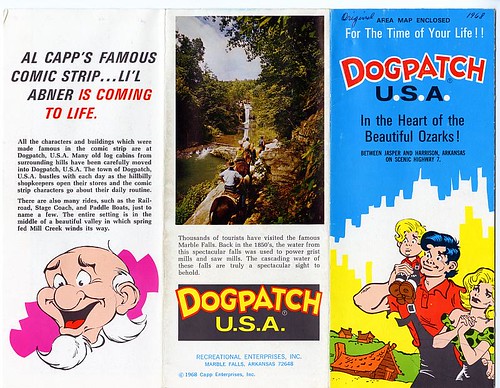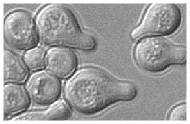This is part three of our look at comics’ contributions to colloquial English.
Another prolific contributor to the language was Al Capp, creator of the strip Li’l Abner.
“My Mom and Dad met when she picked him out at a Sadie Hawkins dance.”

Sadie Hawkins is one of Capp’s memorable characters; she first appeared in November 1937, and until the mid-50s, November was known as Sadie Hawkins month and became an unofficial collegiate holiday.
Hawkins was the ugly daughter of the most wealthy and powerful man in town and was avoided by all the town’s men.
Hawkins’ father lined up all eligible males and shot off his gun. When the gun was fired, they ran for their lives and their freedom from matrimony.
click image to enlarge
The gunshot signaled the unwed women to enter the race and try to catch a man. When an unlucky male was brought back, kicking and screaming, he had no choice but to marry the woman. Thus was born a Dogpatch annual tradition: Sadie Hawkins Day.
Capp also came up with the idea for a Sadie Hawkins dance — a dance where only the ladies picked their partners.
The craze spread throughout the ’40s and ’50s, and continues today.
“Where I grew up, it was the sticks– practically Dogpatch. I couldn’t wait to hit the big city.”
Li’l Abner was a hillbilly who lived in the decidedly backward town of Dogpatch:

Dogpatch came to be a belittling nickname for any small, rural, unsophisticated town, especially in the American south.
Oddly, some folks don’t resent the appellation:
“I skip all the news about Bulgaria and Kazakhstan and so on… who cares what happens in Lower Slobbovia, anyway?”
Lower Slobbovia was Capp’s fictional Iron Curtain country; the term is used as a disparaging dismissal of supposedly unimportant foreign lands.
“A date with Mildred? Come on, she’s a real-life Lena the Hyena!”

In 1946, Al Capp postulated that the ugliest woman in Lower Slobbovia was a certain Lena the Hyena. Every time Lena was in the strip, her face was covered over; readers weren’t happy with this… so Capp, a genius at publicity, organised a nationwide contest to find the ideal drawing of Lena; the jury included Boris Karloff, Frank Sinatra, and Salvador Dali. (My God, to be a fly on the wall at their deliberations!)
The winner was Basil Wolverton (1909–1979), who supplied the above suitably hideous drawing. It created a sensation, being published in Life magazine.
Prior to that, conventionally unattractive women were sometimes called hyenas; for a few years, this cruelty involved Lena the Hyena.
“Gee, bad luck follows Bill everywhere. He’s like that guy with a cloud over his head in the funnies.”

Everyone knows this character, but nobody recalls his name — and no wonder! Joe Btfsplk (pronounced like a Bronx cheer) is Capp’s incarnation of misfortune, as the above shows.
“Let’s shmoo the circuit and see where we stand.”
Perhaps Capp’s most popular invention were the shmoos. These cute little creatures were a boon to mankind, and a deadly menace to the capitalist system: they laid eggs, milk and butter (all pre-packaged) and if a human so much as looked at one hungrily, it died of joy; its flesh tasted of beef, chicken, or pork.
![]()
![]()
Big business has them all exterminated– though some survive in Dogpatch.

The term “shmoo” has entered the English language, defining highly technical concepts in four separate fields of science.
In economics, a “widget” is any material good which is produced through labor from a finite resource—in contrast to a “shmoo“, which is a material good that reproduces itself and is captured or bred as an economic activity (the original shmoo reproduces without requiring any material sustenance). Erik Olin Wright uses the “parable of the shmoo” to introduce discussion of class structure and economics.
In microbiology, the shmoo’s uncanny resemblance to budding yeast—combined with its near-limitless usefulness—has led to the character’s adoption as a mascot of sorts for scientists studying yeast. The cellular bulge that is produced by a haploid yeast cell as a response to a pheromone from the opposite mating type is referred to as a “shmoo“. The whole process is known to biologists as “shmooing.”
yeast cells shmooing
In particle physics, “shmoo” refers to a high energy cosmic ray survey instrument utilized at the Los Alamos National Laboratory. These detectors house scintillators and photomultipliers in an array that gave the detector its distinctive shmoo shape.
A “shmoo plot” is a technical term relating to the shmoo-shaped graphical display patterns of test circuits. In electrical engineering, a “shmoo” is a depiction of the effect of varying two or more components in a test. To shmoo means to run the test.

example of a shmoo plot
Below: Al Capp (right) meets his public:
*********************************************************
“Plato had much to say on senseless warfare. But Walt Kelly’s much-cited possum, Pogo, probably said it best: We have met the enemy, and he is us.” — Mort Rosenblum, Escaping Plato’s Cave ; a comment on the current Iraq war.
Walt Kelly (1913– 1973) wrote and drew the whimsically satirical strip Pogo, featuring the denizens of the Okeefenokee swamp. In 1971, for Earth Day, he drew the following lament against pollution:
The saying is a twist on Commodore Oliver Hazard Perry’s famous dispatch upon winning the Battle of Lake Erie in 1813: ‘We have met the enemy, and they are ours.’
As the Rosenblum quote shows, Kelly’s phrase–” We have met the enemy, and he is us“– is now used to warn against our tendency to self-destructive behavior.
Here’s another often-quoted piece of Kelly wisdom:

…and, more musically:
Kelly parodied the Christmas carol ‘Deck the halls with boughs of Holly‘ with the above ditty. Its popularity was such that ‘Deck us all with Boston Charlie‘ has been adopted all over America as a bona-fide carol.
Here are the full lyrics, for tormenting your neighbors:
Sing it– you’ll enjoy it!

Walt Kelley: self-portrait of the cartoonist at work
**************************************************************
“Every year he expects a promotion, but frankly it’s like expecting the Great Pumpkin— never gonna happen.”

In the Peanuts strip of Charles Shulz (1922 — 2000), the Great Pumpkin is to Hallowe’en what Santa Claus is to Christmas. Every year, despite his sister Lucy’s sarcasm and the skepticism of his friends, little Linus goes to the pumpkin patch to greet his arrival, and every year he is disappointed. Thus the Great Pumpkin became a metaphor for something hoped for in vain.
“He has this tiny teddy bear he carries in his pocket into every meeting– I guess it’s his security blanket.”

Originally, a security blanket was a military measure restricting communications to maintain secrecy. Shulz wittily turned it into a literal blanket– Linus’ constantly-carried comforting fetish.
By extension, a security blanket is any object or mantra or belief that conveys a sense of security or of good luck, no matter how irrationally.
“The first message of this election, for Democrats, is simple: Stop making your base feel like cheerleaders at Charlie Brown’s football game.” — from the blog The Republic of T

Poor Charlie Brown. Year after year, he would run at the football held in position by his nemesis Lucy, and, unfailingly, despite her promises, despite his own wild hopes, she would yank it away just before kickoff and Charlie ended up flat on his back.
Since then, Charlie Brown’s football is used as a metaphor for last-minute disappointment or treachery.
****************************************************************
“No dinner for me– I had a Dagwood for lunch and it damn near killed me.”

A Dagwood sandwich is a tall, multi-layered sandwich made with a variety of meats, cheeses and condiments. It was named after Dagwood Bumstead, a central character in the comic strip Blondie. Dagwood frequently makes enormous sandwiches. The strip creator Chic Young (1901-1973), began drawing the huge sandwiches in the comic strip in 1936. Perhaps this had appeal in the hungry days of the Great Depression?
At any rate, from the get-go people started building real Dagwood sandwiches.
Lunch meats featuring Dagwood and an assortment of meats can be purchased at grocery stores. A counter-service restaurant called Blondie’s opened at Universal Orlando’s Islands of Adventure in May 1999, and serves a traditional Dagwood-style sandwich. Blondie’s bills itself as “Home of the Dagwood Sandwich.”
A Blondie-themed restaurant chain, Dagwood’s Sandwich Shoppe, was founded in 2006. The Dagwood is sold as a 1.5-pound sandwich.
The Dagwood sandwich served in the Dagwood Sandwich Shoppe stacked these ingredients: three slices of deli bread, hard salami, pepperoni, cappicola, mortadella, deli ham, cotto salami, cheddar, Provolone, red onion, green leaf lettuce, tomato, fresh and roasted red bell peppers, mayo, mustard and a secret Italian olive salad oil.

Here’s yet another recipe:
Dagwood Sandwich
serves 2-3 people or one comic strip character
6 slices bread (white, wheat, rye or any combination)
1 sandwich bun
2 oz/60 gr deli ham
2 slices swiss cheese
2 oz/60 gr roast beef
2 slices cheddar cheese
2 slices red onion
3 oz/80 gr salad filling: egg, tuna, chicken potato, ham, etc.
3 slices bacon
4 oz/100 gr deli turkey or turkey leftovers
1 tomato, thinly sliced
3 lettuce leaves
1 gerkhin, halved
2 olives
Mayonnaise, mustard, horseradish, butter, ketchup, as desired
2 long bamboo skewers
**************************************************************
“A Jiggs dinner — just the thing for these cold winter days, eh?”
Dagwood isn’t the only comic strip denizen to have a meal named after him. In Newfoundland and Labrador, a Jiggs dinner is a Sunday meal built around a combination of pickled salt beef (or salt riblets), boiled potatoes, carrots, cabbage, turnips, turnip greens, bread pudding, dressing, pease pudding, and a cooked turkey, chicken or beef roast. Condiments sometimes include mustard, pickles, pickled beets, cranberry sauce and butter.
Its name comes from Jiggs, the hero of Bringing Up Father, the strip by George MacManus (1884– 1954). Jiggs was a rough-hewn Irish immigrant who became a millionaire, and– much to the dismay of his socially ambitious wife Maggie– preferred such homely fare as detailed above to his chef’s refined delicacies.

Dinty (left) and Jiggs at Dinty Moore’s tavern
To this purpose Jiggs would sneak off to the tavern run by Dinty Moore. The character was named after the cartoonist’s friend Peter Moore.
In an odd twist, Peter had his first name legally changed to Dinty, and opened a chain of restaurants in the 1920s called ‘Dinty Moore’s’.
It’s not uncommon for comic strip characters to be named after real people, but here’s a case of a real person named after a comic strip character.
Let’s move on from filling the stomach to punching in the stomach.
*******************************************************
Butch: Starin’ at something, friend?
Vincent: I ain’t your friend, palooka.
Butch: What did you say?
Vincent: I think you heard me just fine, punchy.
— from the film Pulp Fiction, by Quentin Tarantino
Another case where a strip doesn’t coin a phrase, but does inflect its meaning.
The phrase ‘palooka’, variously spelt ‘palucah’ (by Dashiel Hammett) or ‘polokah’, is first recorded in 1923. Probably derived from the ethnic slur ‘Polack’, it originally designated an inept, clumsy brawler.

Ham Fisher (1900 — 1955) christened the hero of his 1930 boxing strip Joe Palooka, thereby fixing the spelling and associating the word with boxers.
( I once met a boxer from Nigeria who was so taken with the strip that he changed his name legally to Kwame Palooka.)
*************************************************************
Next, in part 4– it’s up, up and away with the comic books!
*************************************************************
This is part three of a seven part series; click here for part 1, part 2, also dealing with American comic strips; part 4, part 5 are concerned with comic books; part 6 looks at gag panel and editorial cartoons; part 7 looks at British cartoons; and there’s an index.
I would like to have a part 8, consisting of French, Italian, and other European colloquial languages enriched by their cartoons.
If you have any suggestions for cartoon-derived idioms along the above lines, please mention them in comments– or e-mail me at the yahoo dot com address alexbuchet
**********************************************************
Don’t be put off by the fanboyish homepage of this site. It’s actually an excellent source of information on comics and animation; click on any of the links in the left-hand column to verify this.
This is the official Pogo Possum site.













What a great post! Once, not all that long ago, the American newspaper comics page used to be a haven for creative geniuses. I don’t like to be the one to say it, but how times have changed…
Ain’t it the truth, Mike! Note that nearly all the examples I cite belong to the first half of last century…tsk, tsk…
And thanks for the nice comment!
Pingback: Hey Gainesville, Make Me a Sandwich | Gainesville Scene